#zoroastrianism history
Explore tagged Tumblr posts
Video
tumblr
Explore the ancient wisdom of Zoroastrianism in our latest video! Uncover the fascinating history, beliefs, and practices of this monotheistic faith that dates back thousands of years. From the teachings of the prophet Zoroaster to the significance of fire in their rituals, this video provides a comprehensive insight into one of the world's oldest religions. Join us on a journey to understand the core tenets of Zoroastrianism and the vibrant community of Zoroastrians. Discover the enduring impact of this ancient faith on the world's religious tapestry. Don't miss out on this enlightening exploration! #Zoroastrianism #Zoroastrians #MonotheisticFaith #ReligiousHistory #AncientWisdom #Zoroaster #FaithAndBeliefs #CulturalHeritage #ReligiousDiversity #HistoricalPerspectives #viral #trending #explore
#zoroastrianism#religion#zoroaster#zoroastrians#what is zoroastrianism#overview of zoroastrianism#Monotheist#zoroastrianism explained#What is Zoroastrianism#Zoroastrianism#Islam#what is zoroastrianism religion#what is the ancient religion zoroastrianism#what kind of religion is zoroastrianism#who is zoroaster#zoroastrianism history#ancient iran#hinduism explained#what is buddhism#what is hinduism#zoroastrianism in iran#Polytheism#viral#trending#Explore More
4 notes
·
View notes
Photo

Ancient Persian Religion & Mythology
Ancient Persian religion developed in the region of Greater Iran by the 3rd millennium BCE and corresponds to what is known today as ancient Persian mythology. This belief system informed the Persian Achaemenid Empire, even after the acceptance of Zoroastrianism, as well as the later Parthian Empire and Sassanian Empire. Zoroastrianism is still practiced today.
The ancient religion of Iran was polytheistic and was eventually replaced by the monotheism of Zoroastrianism. Even so, shrines and sites sacred to deities such as Mithra and Anahita continued to draw adherents up through the 7th century CE when the region was conquered by the Arab Muslims.
Continue reading...
186 notes
·
View notes
Text
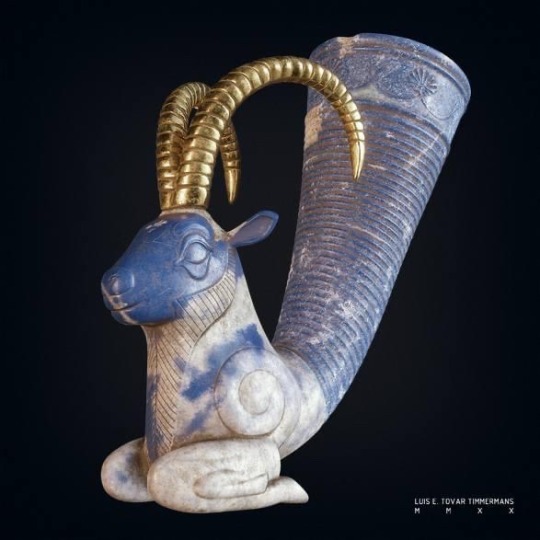
In the heart of the ancient Achaemenid Empire, a masterpiece of Persian artistry emerges—a rhyton (drinking horn or in the shape of a horn) carved from the deep blue lapis lazuli and adorned with gold, taking the form of a majestic ibex (mountain goat).
Dating back to the 6th to 5th century BCE, this exquisite ceremonial vessel not only exemplifies the sophisticated craftsmanship and rich symbolism of the time but also provides a fascinating glimpse into the cultural and economic prowess of ancient Persia.
[Description and Material]:
*Material:
Lapis lazuli, a semi-precious stone prized for its deep blue color, was highly valued in ancient Persia and sourced primarily from what is now Afghanistan.
*Form:
The rhyton is shaped like an ibex, a type of wild goat with prominent, curved horns, reflecting the importance of nature and animal motifs in Persian art.
[Use]:
*Function:
A rhyton is a type of vessel typically used for drinking or pouring liquids, especially in ceremonial contexts. The liquid would be poured from the top and flow out through the spout, which could be the mouth of the animal in this case.
*Ceremonial Role:
Rhytons were often used in religious and royal ceremonies. The choice of lapis lazuli and the intricate craftsmanship suggest that this particular rhyton was likely used by the elite, possibly in rituals associated with the Zoroastrian religion or royal banquets.
[Cultural and Historical Significance]:
*Art and Symbolism: The ibex design reflects the importance of wildlife in Persian culture and the symbolic use of animals in conveying power and divinity. The ibex, with its strong and agile form, could symbolize qualities such as strength and resilience.
*Trade and Wealth: The use of lapis lazuli indicates extensive trade networks and the wealth of the Achaemenid Empire, as this material was not locally sourced and had to be imported.
*Royal Patronage: The Achaemenid rulers were great patrons of the arts, and such luxurious items underscore their desire to display their wealth, power, and cultural sophistication.
[Academic Perspective on Material Culture]:
*Cultural Synthesis:
Scholars often view Achaemenid art, including rhytons, as a synthesis of various cultural influences, including Mesopotamian, Egyptian, and Greek, reflecting the diverse and cosmopolitan nature of the empire.
*Representation of Power:
Academics see these artifacts as representations of royal propaganda, showcasing the divine right and grandeur of the Persian kings.
*Symbol of Status:
In material culture studies, such high-quality items are considered symbols of social status and wealth. They provide insights into the social hierarchy and economic conditions of the time.
*Artistic Techniques:
The craftsmanship of the rhyton is analyzed for its artistic techniques, such as carving and polishing lapis lazuli, which indicate advanced skills and aesthetic values.
[Notable Examples]:
Museums and Collections: Notable examples of such rhytons can be found in major museum collections, such as the British Museum and the Louvre, where they are studied and displayed as prime examples of Achaemenid artistry and craftsmanship.
In conclusion, the lapis lazuli rhyton in the shape of an ibex from the Achaemenid period is a significant artifact that illustrates the artistic, cultural, and economic aspects of ancient Persia. It serves as a key piece of material culture, providing valuable insights into the ceremonial practices, trade networks, and socio-political dynamics of the Achaemenid Empire.
#ancient Persia#Zoroastrianism#ceremonial vessel#rhyton#lapis lazuli#Iran#Mesopotamia#Ancient history#Near East#ancient civilisations#ancient art#ancient craft#archaeology#Achaemenid#Achaemenid Culture
62 notes
·
View notes
Text
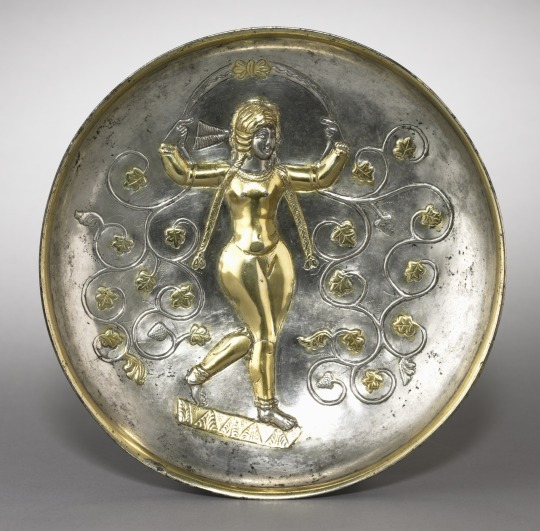
The Goddess Anahita on Sasanian dish 5th-6th C. CE. Silver gilt. Overall: 4.6 x 21.6 cm (1 13/16 x 8 1/2 in.). Weight: 523 g (1.15 lbs.).
"Anahita, the Zoroastrian Goddess of water and fertility, was one of the last of the ancient tradition of Near Eastern nude mother Goddesses."
-taken from The Cleveland Museum of Art
#ancient history#ancient persia#persian#art#art history#pagan#paganism#goddess#mother goddess#anahita#zoroastrianism
131 notes
·
View notes
Text
Finally...


My historical and religious aesthetics 🔥💫:
A/n: you can make and add your own aesthetic by rebbloging this so I can see yours too =) good luck ✨️
#kingdom of heaven#fandom#aesthetic#artists on tumblr#ancient history#ancient persia#ancient#zoroastrianism#zoroaster#zarathustra#avesta#books#challenge#baldwin iv#koh fandom
39 notes
·
View notes
Text

Look at this beautiful ossuary.
#history#ancient history#zoroastrianism#ancient iran#ancient persia#sasanian empire#sassanian empire#zoroastrian priests#sogdian#fire temple
48 notes
·
View notes
Text
Countries that are no more: Achaemenid Empire (550BC-330BC)
It was not the first empire of Iranian peoples, but it arose as probably the greatest in terms of influence and became the measure by which all subsequent Iranian empires tended to compare themselves and its influence on culture, government & civil infrastructure would influence others beyond the span of its territory and the span of time. This is the Achaemenid Empire.
Name: In Old Persian it was known as Xšāça or the "The Kingdom or the Empire", it was named the Achaemenid Empire by later historians. Named after the ruling dynasty established by its founder Cyrus the Great who cited the name of his ancestor Haxāmaniš or Achaemenes in Greek as progenitor of the dynasty. It is sometimes also referred to as the First Persian Empire. The Greeks simply referred to it as Persia, the name which stuck for the geographic area of the Iranian plateau well into the modern era.
Language: Old Persian & Aramaic were the official languages. With Old Persian being an Iranian language that was the dynastic language of the Achaemenid ruling dynasty and the language of the Persians, an Iranian people who settled in what is now the southwestern Iranian plateau or southwest Iran circa 1,000 BC. Aramaic was a Semitic language that was the common and administrative language of the prior Neo-Assyrian & Neo-Babylonian Empires which centered in Mesopotamia or modern Iraq, Syria & Anatolian Turkey. After the Persian conquest of Babylon, the use of Aramaic remained the common tongue within the Mesopotamian regions of the empire, eventually becoming a lingua franca across the land. As the empire spread over a vast area and became increasingly multiethnic & multicultural, it absorbed many other languages among its subject peoples. These included the Semitic languages Akkadian, Phoenician & Hebrew. The Iranian language of Median among other regional Iranian languages (Sogdian, Bactrian etc). Various Anatolian languages, Elamite, Thracian & Greek among others.
Territory: 5.5 million kilometers squared or 2.1 million square miles at its peak circa 500BC. The Achaemenid Empire spanned from southern Europe in the Balkans (Greece, Bulgaria, European Turkey) & northwest Africa (Egypt, Libya & Sudan) in the west to its eastern stretches in the Indus Valley (Pakistan) to parts of Central Asia in the northeast. It was centered firstly in the Iranian Plateau (Iran) but also held capitals in Mesopotamia (Iraq). Territory was also found in parts of the Arabian Peninsula & the Caucausus Mountains.
Symbols & Mottos: The Shahbaz or Derafsh Shahbaz was used as the standard of Cyrus the Great, founder of the empire. It depicts a bird of prey, typically believed to be a falcon or hawk (occasionally an eagle) sometimes rendered gold against a red backdrop and depicts the bird holding two orbs in its talons and adorned with an orb likewise above its head. The symbolism was meant to depict the bird guiding the Iranian peoples to conquest and to showcase aggression & strength coupled with dignity. The imperial family often kept falcons for the pastime of falconry.
Religion: The ancient Iranian religion of Zoroastrianism served as the official religion of the empire. It was adopted among the Persian elite & and had its unique beliefs but also helped introduce the concept of free-will among its believers, an idea to influence Judaism, Christianity & Islam in later centuries. Despite this official religion, there was a tolerance for local practices within the subject regions of the empire. The ancient Mesopotamian religion in Babylon & Assyria, Judaism, the Ancient Greek & Egyptian religions & Vedic Hinduism in India was likewise tolerated as well. The tolerance of the Achaemenids was considered a relative hallmark of their dynasty from the start. Famously, in the Old Testament of the Bible it was said that it was Cyrus the Great who freed the Jews from their Babylonian captivity and allowed them to return to their homeland of Judea in modern Israel.
Currency: Gold & silver or bimetallic use of coins became standard within the empire. The gold coins were later referred to as daric and silver as siglos. The main monetary production changes came during the rule of Darius I (522BC-486BC). Originally, they had followed the Lydian practice out of Anatolia of producing coins with gold, but the practice was simplified & refined under the Achaemenids.
Population: The estimates vary ranging from a low end of 17 million to 35 million people on the upper end circa 500BC. The official numbers are hard to determine with certainty but are generally accepted in the tens of millions with the aforementioned 17-35 million being the most reasonable range based on available sources.
Government: The government of the Achaemenid Empire was a hereditary monarchy ruled by a king or shah or later referred to as the ShahanShah or King of Kings, this is roughly equivalent to later use of the term Emperor. Achaemenid rulers due the unprecedented size of their empire held a host of titles which varied overtime but included: King of Kings, Great King, King of Persia, King of Babylon, Pharaoh of Egypt, King of the World, King of the Universe or King of Countries. Cyrus the Great founded the dynasty with his conquest first of the Median Empire and subsequently the Neo-Babylonians and Lydians. He established four different capitals from which to rule: Pasargadae as his first in Persia (southwest central Iran), Ecbatana taken from the Medians in western Iran's Zagros Mountains. The other two capitals being Susa in southwest Iran near and Babylon in modern Iraq which was taken from the Neo-Babylonians. Later Persepolis was made a ceremonial capital too. The ShahanShah or King of Kings was also coupled with the concept of divine rule or the divinity of kings, a concept that was to prove influential in other territories for centuries to come.
While ultimate authority resided with the King of Kings and their bureaucracy could be at times fairly centralized. There was an expansive regional bureaucracy that had a degree of autonomy under the satrapy system. The satraps were the regional governors in service to the King of Kings. The Median Empire had satraps before the Persians but used local kings they conquered as client kings. The Persians did not allow this because of the divine reverence for their ShahanShah. Cyrus the Great established governors as non-royal viceroys on his behalf, though in practice they could rule like kings in all but name for their respective regions. Their administration was over their respective region which varied overtime from 26 to 36 under Darius I. Satraps collected taxes, acted as head over local leaders and bureaucracy, served as supreme judge in their region to settle disputes and criminal cases. They also had to protect the road & postal system established by the King of Kings from bandits and rebels. A council of Persians were sent to assist the satrap with administration, but locals (non-Persian) could likewise be admitted these councils. To ensure loyalty to the ShahanShah, royal secretaries & emissaries were sent as well to support & report back the condition of each satrapy. The so called "eye of the king" made annual inspections of the satrapy to ensure its good condition met the King of Kings' expectations.
Generals in chief were originally made separate to the satrap to divide the civil and military spheres of government & were responsible for military recruitment but in time if central authority from the ShahanShah waned, these could be fused into one with the satrap and general in chiefs becoming hereditary positions.
To convey messages across the widespread road system built within the empire, including the impressive 2,700 km Royal Road which spanned from Susa in Iran to Sardis in Western Anatolia, the angarium (Greek word) were an institution of royal messengers mounted on horseback to ride to the reaches of the empire conveying postage. They were exclusively loyal to the King of Kings. It is said a message could be reached to anywhere within the empire within 15 days to the empire's vast system of relay stations, passing message from rider to rider along its main roads.
Military: The military of the Achaemenids consisted of mostly land based forces: infantry & cavalry but did also eventually include a navy.
Its most famous unit was the 10,000-man strong Immortals. The Immortals were used as elite heavy infantry were ornately dressed. They were said to be constantly as 10,000 men because for any man killed, he was immediately replaced. Armed with shields, scale armor and with a variety of weapons from short spears to swords, daggers, slings, bows & arrows.
The sparabara were the first line of infantry armed with shields and spears. These served as the backbone of the army. Forming shield walls to defend the Persian archers. They were said to ably handle most opponents and could stop enemy arrows though their shields were vulnerable to enemy spears.
There was also the takabara light infantry and though is little known of them it seems they served as garrison troops and skirmishers akin to the Greek peltast of the age.
The cavalry consisted of four distinct groups: chariot driven archers used to shoot down and break up enemy formations, ideally on flat grounds. There was also the traditional horse mounted cavalry and also camel mounted cavalry, both served the traditional cavalry functions and fielded a mix of armor and weapons. Finally, there was the use of war elephants which were brought in from India on the empire's eastern reaches. These provided archers and a massive way to physically & psychologically break opposing forces.
The navy was utilized upon the empire's reaching the Mediterranean and engaged in both battles at sea and for troop transport to areas where troops needing deploying overseas, namely in Greece.
The ethnic composition of Achaemenid military was quite varied ranging from a Persian core with other Iranian peoples such as the Medians, Sogdian, Bactrians and Scythians joining at various times. Others including Anatolians, Assyrians, Babylonians, Anatolians, Indians, Arabs, Jews, Phoenicians, Thracians, Egyptians, Ethiopians, Libyans & Greeks among others.
Their opponents ranged from the various peoples they conquered starting with the Persian conquest of the Medians to the Neo-Babylonians, Lydians, Thracians, Greeks, Egyptians, Arabs & Indians and various others. A hallmark of the empire was to allow the local traditions of subjugated areas to persist so long as garrisons were maintained, taxes were collected, local forces provided levies to the military in times of war, and they did not rebel against the central authority.
Economy: Because of the efficient and extensive road system within the vast empire, trade flourished in a way not yet seen in the varied regions it encompassed. Tax districts were established with the satrapies and could be collected with relative efficiency. Commodities such as gold & jewels from India to the grains of the Nile River valley in Egypt & the dyes of the Phoenicians passed throughout the realm's reaches. Tariffs on trade & agricultural produce provided revenue for the state.
Lifespan: The empire was founded by Cyrus the Great circa 550BC with his eventual conquest of the Median & Lydian Empires. He started out as Cyrus II, King of Persia a client kingdom of the Median Empire. His reign starting in 559BC. Having overthrown and overtaken the Medians, he turned his attention Lydia and the rest of Anatolia (Asia Minor). He later attacked the Eastern Iranian peoples in Bactria, Sogdia and others. He also crossed the Hindu Kush mountains and attacked the Indus Valley getting tribute from various cities.
Cyrus then turned his attention to the west by dealing with the Neo-Babylonian Empire. Following his victory in 539BC at the Battle of Opis, the Persians conquered the Babylonia with relative quickness.
By the time of Cyrus's death his empire had the largest recorded in world history up to that point spanning from Anatolia to the Indus.
Cyrus was succeeded by his sons Cambyses II and Bardiya. Bardiya was replaced by his distant cousin Darius I also known as Darius the Great, whose lineage would constitute a number of the subsequent King of Kings.
Darius faced many rebellions which he put down in succession. His reign is marked by changes to the currency and the largest territorial expansion of the empire. An empire at its absolute zenith. He conquered large swaths of Egypt, the Indus Valley, European Scythia, Thrace & Greece. He also had exploration of the Indian Ocean from the Indus River to Suez Egypt undertaken.
The Greek kingdom of Macedon in the north reaches of the Hellenic world voluntarily became a vassal of Persia in order to avoid destruction. This would prove to be a fateful first contact with this polity that would in time unite the Greek-speaking world in the conquest of the Achaemenid Empire. However, at the time of Darius I's the reign, there were no early indications of this course of events as Macedon was considered even by other Greek states a relative backwater.
Nevertheless, the Battle of Marathon in 490BC halted the conquest of mainland Greece for a decade and showed a check on Persia's power in ways not yet seen. It is also regarded as preserving Classical Greek civilization and is celebrated to this day as an important in the annals of Western civilization more broadly given Classical Greece & in particular Athens's influence on western culture and values.
Xerxes I, son of Darius I vowed to conquer Greece and lead a subsequent invasion in 480BC-479BC. Xerxes originally saw the submission of northern Greece including Macedon but was delayed by the Greeks at the Battle of Thermopylae, most famously by Spartan King Leonidas and his small troop (the famed 300). Though the Persians won the battle it was regarded as a costly victory and one that inspired the Greeks to further resistance. Though Athens was sacked & burnt by the Persians, the subsequent victories on sea & land at Salamis & Plataea drove the Persians back from control over Greece. Though war would rage on until 449BC with the expulsion of the Persians from Europe by the Greeks.
However, the Greeks found themselves in a civil war between Athens & Sparta and Persia having resented the Athenian led coalition against their rule which had expelled them from Europe sought to indirectly weaken the Greeks by supporting Greek factions opposed to Athens through political & financial support.
Following this reversal of fortune abroad, the Achaemenid Empire not able to regain its foothold in Europe, turned inward and focused more on its cultural development. Zoroastrianism became the de-facto official religion of the empire. Additionally, architectural achievements and improvements in its many capitals were undertaken which displayed the empire's wealth. Artaxerxes II who reigned from 405BC-358BC had the longest reign of any Achaemenid ruler and it was characterized by relative peace and stability, though he contended with a number of rebellions including the Great Satraps Revolt of 366BC-360BC which took place in Anatolia and Armenia. Though he was successful in putting down the revolt. He also found himself at war with the Spartans and began to sponsor the Athenians and others against them, showcasing the ever dynamic and changing Greco-Persian relations of the time.
Partially for safety reasons, Persepolis was once again made the capital under Artaxerxes II. He helped expand the city and create many of its monuments.
Artaxerxes III feared the satraps could no longer be trusted in western Asia and ordered their armies disbanded. He faced a campaign against them which suffered some initial defeats before overcoming these rebellions, some leaders of which sought asylum in the Kingom of Macedon under its ruler Philip II (father of Alexander the Great).
Meanwhile, Egypt had effectively become independent from central Achaemenid rule and Artaxerxes III reinvaded in around 340BC-339BC. He faced stiff resistance at times but overcame the Egyptians and the last native Egyptian Pharaoh Nectanebo II was driven from power. From that time on ancient Egypt would be ruled by foreigners who held the title Pharaoh.
Artaxerxes III also faced rebellion from the Phoenicians and originally was ejected from the area of modern coastal Lebanon, Syria & Israel but came back with a large army subsequently reconquered the area including burning the Phoenician city of Sidon down which killed thousands.
Following Artaxerxes III's death his son succeeded him but a case of political intrigue & dynastic murder followed. Eventually Darius III a distant relation within the dynasty took the throne in 336BC hoping to give his reign an element of stability.
Meanwhile in Greece, due to the military reforms and innovations of Philip II, King of Macedon, the Greek speaking world was now unified under Macedon's hegemony. With Philip II holding the title of Hegemon of the Hellenic League, a relatively unified coalition of Greek kingdoms and city-states under Macedon premiership that formed to eventually invade Persia. However, Philip was murdered before his planned invasion of Asia Minor (the Achaemenid's westernmost territory) could commence. His son Alexander III (Alexander the Great) took his father's reforms and consolidated his hold over Greece before crossing over to Anatolia himself.
Darius III had just finished reconquering some rebelling vestiges of Egypt when Alexander army crossed over into Asia Minor circa 334BC. Over the course of 10 years Alexander's major project unfolded, the Macedonian conquest of the Persian Empire. He famously defeated Persians at Granicus, Issus and Gaugamela. The latter two battles against Darius III in person. He took the King of Kings family hostage but treated them well while Darius evacuated to the far eastern reaches of his empire to evade capture. He was subsequently killed by one of his relatives & satraps Bessus, whom Alexander eventually had killed. Bessus had declared himself King of Kings though this wasn't widely recognized and most historians regard Darius III, the last legitimate ShahanShah of Achaemenids.
Alexander had taken Babylon, Susa & Persepolis by 330BC and effectively himself was now ruler of the Persian Empire or at least its western half. In addition to being King of Macedon & Hegemon of the Hellenic League, he gained the titles King of Persia, Pharaoh of Egypt & Lord of Asia. Alexander would in time eventually subdue the eastern portions of the Achaemenid realm including parts of the Indus Valley before turning back to Persia and Babylon where he subsequently became ill and died in June 323BC at age 32. Alexander's intentions it appears were never to replace the Achaemenid government & cultural structure, in fact he planned to maintain and hybridize it with his native Greek culture. He was in fact an admirer of Cyrus the Great (even restoring his tomb after looting) & adopted many Persian customs and dress. He even allowed the Persians to practice their religion and had Persian and Greeks start to serve together in his army. Following his death and with no established successor meant the empire he established which essentially was the whole Achaemenid Empire's territory in addition to the Hellenic world fragmented into different areas run by his most trusted generals who established their own dynasties. The Asian territories from Anatolia to the Indus (including Iran and Mesopotamia) gave way to the Hellenic ruled Seleucid Empire while Egypt became the Hellenic ruled Ptolemaic Kingdom. The synthesis of Persian and Greek cultures continued in the Seleucid and Greco-Bactrian kingdoms of antiquity.
The Achaemenid Empire lasted for a little over two centuries (550BC-330BC) but it casted a long shadow over history. Its influence on Iran alone has persisted into the modern age with every subsequent Persian Empire claiming to be its rightful successor from the Parthian & Sasanian Empires of pre-Islamic Iran to the Safavids of the 16th-18th century and the usage of the title Shah until the last Shah's ejection from power in the 1979 Islamic Revolution. Even the modern Islamic Republic of Iran uses Achaemenid imagery in some military regiments and plays up its importance in tourism and museums as a source of pride to Persian (Farsi) & indeed Iranian heritage. Likewise, its form of governance and the pushing of the concept of divine rights of kings would transplant from its Greek conquerors into the rest of Europe along with various other institutions such as its road & mail system, tax collection & flourishing trade. Its mix of centralized & decentralized governance. Its religious & cultural tolerance of local regions even after their conquest would likewise serve as a template for other empires throughout history too. The Achaemenid Empire served as a template for vast international & transcontinental empires that would follow in its wake & surpass its size & scope of influence. However, it is worth studying for in its time, it was unprecedented, and its innovations so admired by the likes of Alexander the Great and others echo into the modern era.
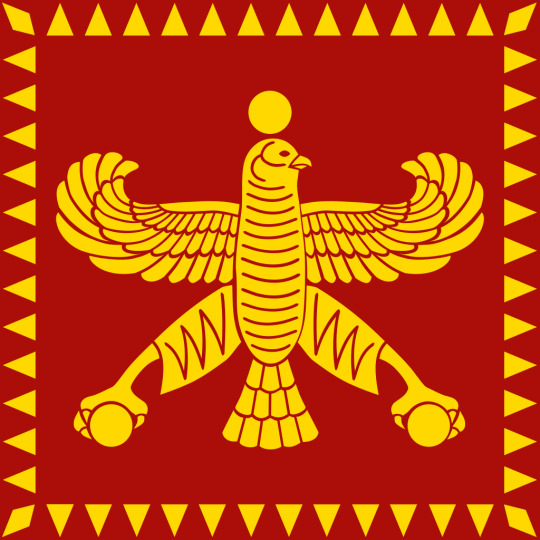
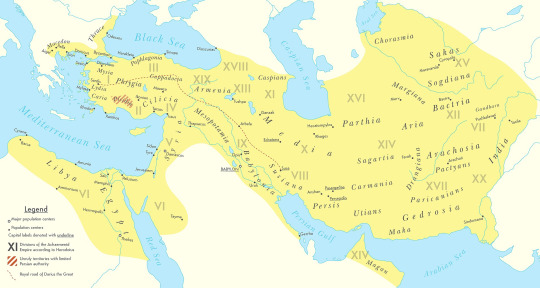


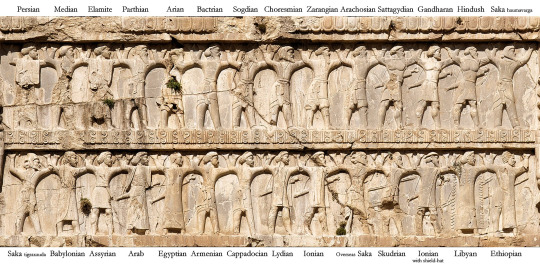
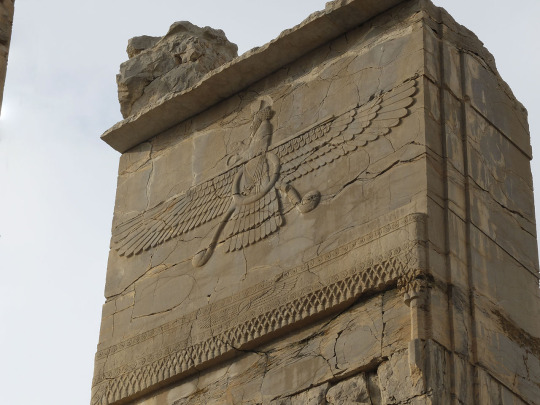




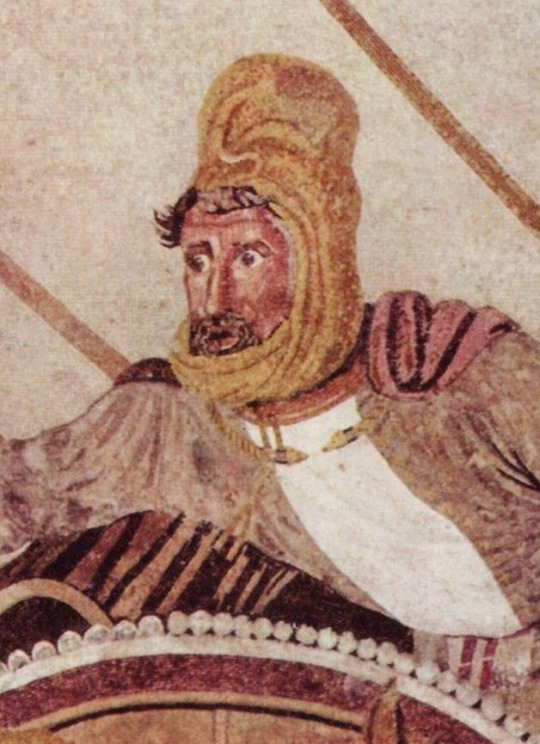
#military history#antiquity#iran#greece#ancient greece#classical greece#ancient ruins#ancient iran#ancient persia#achaemenid#persia#zoroastrianism#alexander the great#cyrus the great#xerxes#artwork#government#history#persian empire#ancient egypt
102 notes
·
View notes
Text
Star Wars saga full of Jewish references and themes. Did you know Yoda was Jewish?
Like so many of you, I am anxiously awaiting the release of Star Wars Episode VII: The Force Awakens.
A long time ago in a galaxy far away…1977 actually…we were introduced to this most amazing epic, and appreciation has only grown over the ensuing years. The characters have become embedded in American culture.
For most fans, Star Wars is great entertainment, and it is definitely that…and much more.
The Star Wars series is eclectic. It combines many religious, philosophical and historic themes taken from a wide array of religions, including Zoroastrianism, Taoism, Stoicism, Nihilism, Christianity and also Judaism. A student of any of these religions will find something of their own faith somewhere in Star Wars.
College level classes have been taught on the mythology and symbolism that are so much a part of Star Wars. There is even a book entitled “Star Wars and Philosophy: More Powerful than You Can Possibly Imagine” which is a compilation written by various college professors.
Most prominently, the conflict between “light” and “dark” sides of the Force comes almost directly from Zoroastrianism and their intertwining connection certainly is a reflection of the yin and yang of Taoism. And there is much more. The strong ethical element to Star Wars bears a direct connection to various ideals of Buddhism and Stoicism.
The virtues the Jedi shares with the Stoic sages are patience, commitment, seriousness, calm, caution, benevolence, and, of course, wisdom. Given all these virtues, Yoda is what the ancient Stoics described as the sage, the ideal person who has perfected reason and achieved complete wisdom. Speaking of Yoda, students of Hebrew will recognize several choices of names in the films as having Hebrew roots. Yoda most obviously comes from the Hebrew word Yodea, meaning one with knowledge.
Both Judaism and Christianity are reflected in Star Wars, philosophically and historically. Particularly concerning the depiction of the eternal conflict between good and evil, students of Judaism will recognize the yetzer ha-tov vs. the yetzer ha-ra, the opposing human inclinations present in every person. There may even be a connection to the Dead Sea Scrolls, one of which is entitled “The War of the Sons of Light Against the Sons of Darkness.”
The struggle between good and evil in Star Wars seems closer to the Christian concept where good and evil are competing and independent powers battling over the domain of creation. Judaism, of course, sees everything as emanating from a single Creator. This includes evil that has no independent will of its own to oppose God, but is also under God’s domain, as is portrayed in the Book of Job.
Judaism teaches that the source of Light and Darkness are One and the same, as it says in the prayer book: “Blessed art You, Eternal One, our God, Ruler of the Universe, Who forms light and creates darkness, Who makes peace and creates all things.” The source for this line of liturgy can be found in the Hebrew Bible, Isaiah 45:7: “Who forms light and creates darkness, Who makes peace and creates evil; I am the Eternal One, Who makes all these.”
The ever-present and overarching theme of Star Wars is that of the Force that endows these films with their undeniable spiritual orientation. The Force is what gives a Jedi his power. It’s an energy field created by all living things. It binds the galaxy together.
Call it what you like; it sounds like God to me.
The expression “May the Force be with you” is emblematic of the Star Wars legacy. This line is invoked by at least one character in each of the Star Wars movies. To those familiar with the Catholic Mass, these words seem to directly reflect Dominus vobiscum, the Latin phrase meaning “The Lord be with you” – the ancient salutation and blessing traditionally used by the clergy in the Roman Catholic Mass, and several other Christian denominations.
In other ways, the Force has taken on Christian overtones. In “The Phantom Menace,” Anakin Skywalker (Darth Vader as a boy) is supposedly the result of a virgin birth.
And there are suggestions of Messianism as well. The idea of a foretold “Chosen One” who would restore balance to the Force is a theme running throughout the Star Wars films.
I do not believe that George Lucas set out to create a science fiction universe intended specifically to reflect Jewish history. Nevertheless, the allusions are apparent to Jews. Darth Vader and company are Nazis and Storm Troopers – the embodiment of all that is evil and destructive.
Since it is Chanukah, I should add that the heroes of Star Wars, the members of a “rebel alliance,” are the few against the many. They could be the Maccabees in outer space, the small band of determined fighters who struggled against the overwhelming power of the Greek Syrians, or they could be the partisans and defenders of the Warsaw Ghetto who did all that they could to resist the Nazis.
This brief essay actually is only scratching the surface. Stars Wars is so much more than science fiction. On so many levels, it is a serious endeavor dealing with universal human concerns that are confronted by all of the world’s religions. Its universalistic moral themes, as much as its originality and cinematic genius, are what endows Star Wars with timeless value.
#wooloo-writes#wooloo writes#star wars#sw#jedi#jedi and judaism#yoda#judaism#jumblr#philosophy#history#hebrew#jedi philosophy#jewish philosophy#zoroastrianism#taoism#buddhism
9 notes
·
View notes
Text

“Several times he is invoked in company with Ahura: the two gods form a pair, for the light of Heaven and Heaven itself are in their nature inseparable. Furthermore, if it is said that Ahura created Mithra as he did all things, it is likewise said that he made him just as great and worthy as himself. Mithra is indeed a yazata, but he is also the most potent and most glorious of the yazatas.”
-Franz Cumont in “The Mysteries of Mithra”.
Photo is a depiction of Antiochus I of Commagene shaking the hand of Mithra.
#books#history#literature#religion#theology#mysticism#esotericism#religious#paganism#polytheism#zoroastrianism#Mithra#Ancient Greece#greek#ancient#ancient history#philosophy#quotes#book quote
9 notes
·
View notes
Text
“ What land should I flee to?
Where should I go to flee?
From my family and from my clan
They banish me.
The community to which
I belong has not satisfied me
Nor have [the rulers] of the country.
How, Thee, can I satisfy, O Mazda Ahura? ” (Yasna 46.1)
Zarathustra, prophet of Zoroastrianism, after his vision that monotheism must be the only true god, debated all those among the priestly class and won in each case, but the king still wanted to throw him in prison. Around this time, he wrote these lines. Only some time later, after a private audience with the King, did the King come to understand his ideas, seeing that the priestly classes main concern was a threat to their power, and he changed his mind, granting him his life.
#zoro#zoroaster#zarathustra#persian#iran#persia#history#religion#religious history#archeology#ancient history#ancient religion#zoroastrianism#religious studies#monotheism#spirituality#quotes#literature#interesting#facts
24 notes
·
View notes
Text
Top 10 Oldest Religions
Reblogging is allowed
Music:
#religion#history#history of religion#edits#my edit#christianity#hinduism#judaism#taoism#confucianism#zoroastrianism#tengri#tengrism#jainism#buddhism#shinto#shintoism#Spotify
6 notes
·
View notes
Text

Mithraic relief
Marble (restored)
Rome, AD 100-200
In Persian Zoroastrianism, Mithras was a god of light, truth, and the promised word. In this Roman relief, he wears the Persian costume of folded cap, tunic, and trousers. Mithraism was adapted by the Romans as a mystery cult, much favoured by the Roman army. The cult was exclusively for men. The slaying of the mystic bull implies the triumph of good over evil, the giving of immortality and happiness beyond the grave.
48 notes
·
View notes
Text





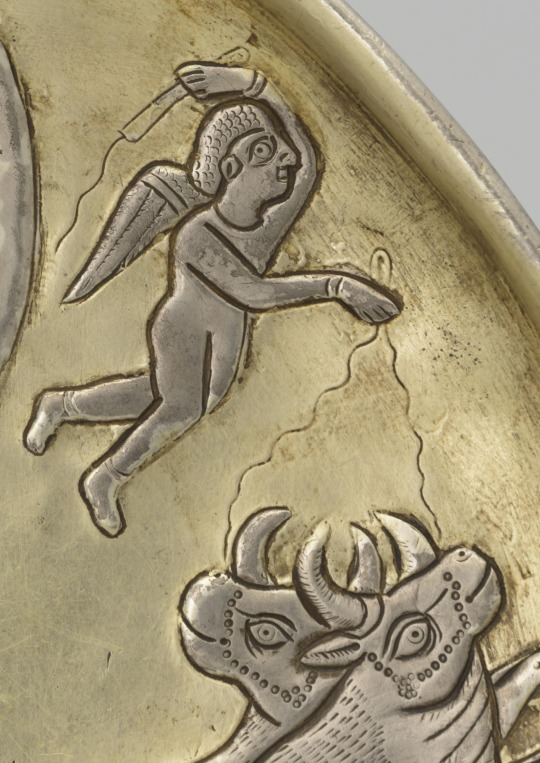
Sassanid silver plate 7th C. CE. Decorated with a figure seated on a couch in a crescent moon and a figure standing in an archway. Found in Klimova, Russia in 1907. The base of the vessel appears to have runic script scratched into it. This item is sometimes referred to as The ‘Clock of Khosrow’ or The ‘Throne of Khosrow’ Plate. Diameter: 21.6cm.
I'm just going to do a brief summary of what caused Persia to fall to Islam.
The Islamic invasion of Persia began sometime between 628-632 CE. From 541 CE to this time Persia had been exhausted by an almost constant state of war. Most of the fighting was with the Byzantine Empire in the west: The Lazic War (541-562), Byzantine–Sasanian War of 572–591, Byzantine–Sasanian War of 602–628.
However, there were also wars with the Turks to the north and the east: Perso-Turkic war of 588–589, Perso-Turkic war of 606–608, Perso-Turkic war of 627–629. In this final war the Byzantines and Turks were allies. This alliance took time to come into being but had been sought out by the Turks almost immediately after they destroyed the Hephthalites, indicating they planned to do to the Persians what they had done to the Huns. The medieval historian Movses Kaghankatvatsi described the war of 627-629:
"At the arrival of the all-powerful scourge (universal wrath) confronting us, the invaders [Turks], like billowing waves of the sea, crashed against the walls and demolished them to their foundations. [In Partaw], seeing the terrible danger from the multitude of hideously ugly, vile, broad-faced, without eyelashes, and with long flowing hair like women, which descended upon them, a great terror (trembling) seized the inhabitants. They were even more horrified when they saw the accurate and strong [Khazar] archers, whose arrows rained down upon them like heavy hailstones, and how they [Khazars], like ravenous wolves that had lost all shame, fell upon them and mercilessly slaughtered them on the streets and squares of the city. Their eyes had no mercy for neither the beautiful, nor handsome, nor the young men or women; they did not spare even the unfit, harmless, lame, nor old; they had no pity (compassion, regrets), and their hearts did not shrink at the sight of the babies embracing their murdered mothers; to the contrary, they suckled blood from their breasts like milk."
Ironically, the Sassanid ruler Khosrow I had married a Turkic princess to win an alliance with them so the two could destroy the Huns together in 560 CE at the Battle of Gol-Zarriun. Khosrow I chose his Turkic progeny, Hormizd IV, as ruler over his Persian children. From Iranica Online:
"Hormozd’s character displeased everyone. He antagonized the Zoroastrian clergy, allegedly killing many of them, even the chief mowbed, and alienated the nobility by killing thousands of them (Ṭabari, I, p. 991; tr., V, pp. 297-98; Balʿami, ed. Bahār, pp. 1072-73; Masʿudi, Moruj, ed. Pellat, sec. 632; Šāh-nāma, Moscow, VIII, pp. 319 ff.). In diplomacy he showed inflexibility, even poor judgement. He disrupted the peace negotiations with the Byzantines and made demands (payment of “tribute”) that the Romans could not accept (Menander, frag., 23.9-24-12529). His contemporary, Menander Protector, lamented that “the Romans and the Persians would have made peace, had not Ḵosrow left this life and his son, Hormisdas [Hormizd IV], a truly wicked man, assumed the crown” (tr., pp. 207-9)."
Finally the Sassanid Empire went into a civil war from 628-632 CE where it had become politically decentralized. The Plague of Sheroe also occurred in 627-628 CE, most heavily devastating the populations in the western provinces with some areas experiencing a 50% mortality rate. Afterward, the Arab Muslims flooded into an already ravaged Persia like bacteria infesting an open wound.
104 notes
·
View notes
Text
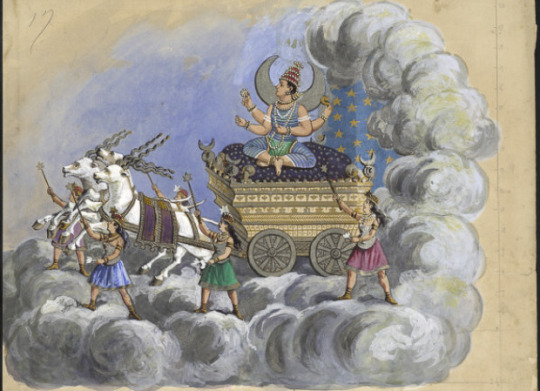
Soma, the divine plant and drink of the Vedic gods. Confers power, vitality, wisdom, healer of ailments, and bestower of riches.
A divine drink. But, what was it? The stories tell us it was a drink made from honey likely and a plant that had to be distilled.
Soma in fact means in Sanskrit: distill, extract, sprinkle. Sounds like words to brew up a...brew.
Interestingly enough, though, scholars theorize that part of the drink was most definitely honey, and....magic mushrooms. Magic Mushroom wine, in fact.
Now, another interesting tidbit is that the Zoroastrians had a similar drink called Haoma - which scholars also theorize was made along the same lines and had the same benefits.
Does divine honey wine sound familiar? <Mead has entered the chat>
Then there is the Greek Ambrosia, nectar of the gods (NECTAR) that can grant immortality, just like some of the drinks I mentioned from other myths.
Here we get into some actual comparative mythology stuff as the concept of immortality linked to drinks exists in written in the Greek and Vedic with the word ambrosia being semantically linked to amṛta - concept of immortality -- food/drink to reach that path. This makes sense because the words come from the proto indo european: ṇ-mṛ-tós, "un-dying".
Many of the early epics seem to feature some kind of overall divine healing plant or divine drink that empowers its heroes. Why is that?
Simple as people just loved booze and the idea of super magic special booze? "Honey, I'm not drinking...I'm communing with god to make the strongest of our bloodline!!!! I SWEAR."
Or...was it something else? Is there a shared older story beat that all these epics draw from?
Right now? People still figuring that out. But there are _some_ connections. And they're fascinating.
(As I don't drink, you'll have to tell me if getting sloshed on honey wine has given you power, magic, healed you, or let you see god.)
In the Vedic stories, the Artisan and craftsman god, Tvashtr, creates this magical drink, along with Indra's lightning bolt (that myth sound familiar?), the creator of forms, living wombs, and oh, he creates vritra, the three-headed asura dragon that captures and holds hostage the waters of the world and is slain by Indra. Vritra becomes so dangerous and empowered by, you guessed it, drinking all the Soma at Tvashtrs house.
Man found the unlimited rare candy glitch. -_-
#soma#vedic gods#Zoroastrian#honey wine#mead#ambrosia#Greek#gods and goddesses#tvashtr#indra#vritra#storytelling#writers on tumblr#folklore#folktales#alcohol#tw alchohol mention#intertwined history#myths and legends#mythology#did you know#how cool is that#greek gods
5 notes
·
View notes
Text
It would be great if I put as much dedication, time and attention that I do into ancient history into something academically useful to me right now.
#host —★#ancient history#ancient iran#sassanian empire#achaemenid#ancient rome#roman empire#zoroastrianism#mithraism#manichaeism
7 notes
·
View notes
Text
A.Z. Foreman is an amazing linguist who's not only an expert in reconstruction who can personally pronounce even dead languages like a native speaker, he's also a translator and poet in his own right. Even just this little bit is amazing, maybe the best translation of the Shahnameh I've yet seen.

Exordium
Now in the name of God all things extol, The Lord of wisdom and the human soul, Beyond which there does not exist a thing Our minds can ever compass, Sovereign King Of all that is, of every name and place, Guide and sustainer of the human race, The cosmic Lord who wheels the stars of night, Who gave the sun, the moon and Venus light, Above all name or thought or signifying, High artificer of the underlying. You can't make out your Maker with your eye However much you strain it. Do not try. Minds can't grasp Him. He is the overall Being unnameable, unplaceable. It would take more than sapience to attain Things so beyond this elemental plane. Our minds with every word in their command Have only words for what they understand, So none knows how to praise Him as He is. Just bind yourself in reverence. You are His. He measured out the intellect, defined The soul of man. How would a measured mind Contain Him? Could the implements of thought Or soul or language rightly praise what brought Them into being? You need but confess That He exists, and speak no idleness. Seek the right path. Have reverence and awe, And go about with care to heed His law. This is the fact: to know is to be strong. And knowing God will turn the old heart young. But words can never pierce the veil we see. Our mind will never touch His quiddity.
In Praise of Reason
Now that I see the chance for it arise Here let me talk of reason to the wise, For it is greater than God's other gifts. Better its praise than justice. It uplifts The heart. It is life's vanguard, guides the vexed. It is your aid in this world and the next, Your fount of grief and joy, the origin Of every moment that you lose or win. If it goes dark, even the brightest soul Will never live a day of feeling whole Or happy. So a man of eloquence Once said to nourish our intelligence: "Whoever does not pay his wisdom heed Will slice himself to shreds with every deed, Wise men deem him an idiot and a danger As his own people turn him out a stranger." In this world as the next, it keeps you free. The man whose reason breaks finds slavery. For reason is the sole eye of the soul. The eyeless in this world have no control. It was created first, before all else, To brace the soul and the three sentinels Called eye and ear and tongue. These are the three That bring about all ill and good you see. Who can praise soul and reason fitly here? Even if I were fit to, who could hear? Since we're unfit to speak about all this, Let's hear instead how God made all that is. You, authored by the Lord who willed the days, Don't know this world's overt or covert ways. Let those who know show you the way. Go on Throughout this world, and talk to everyone. And when you've heard all wise men have to say, Still don't stop learning for a single day. Then, when you reach the high word-branches, know That knowledge cannot reach the root below.
The Creation of the World
You need to know the truth, as we begin, Of this world's elemental origin, When out of nothing God created matter In order for His potency to matter. From it, the stuff of the four elements Came in no time and with no toil. Immense Fire arose shining, burning into birth, Then wind and water flowed upon dark earth. First, fire was blown to motion. Hot and high It blazed till there was such a thing as dry. Then it was stilled again as cold took hold, And the first moisture grew out of the cold. The elements existed now, and curled Together so to form our fleeting world. Combining and compounding genera Formed the high orders of phenomena. So came the skydome spinning black and blue With wonders at full tilt, forever new, Revealing stars and planets and their signs, Each in its place, befitting His designs. The spheres were shaped inside each other, cast In motion as the structure set. At last, With sea and desert, dale and mountain height, The earth shone like a colored lamp at night. The mountains loomed. The waters coalesced And every sprouting plant reared up its crest. But Earth itself received no place on high. It was the darkling axis. In the sky A starfield's wonders blazoned overhead Lighting the earth up with the sheen they shed. Fire surges up. Water pours down. The sun Goes round the earth to make its daily run. Grass sprouted up with the assorted trees Happily pressing their heads upward. These Just grow and do not move, for they lack all The animacy of an animal. Animals soon appeared. Those moving things Tamed growing plants beneath their legs and wings. They eat and sleep and rest, and so they thrive. Their satisfaction lies in being alive. No speaking tongue, no seeking mind, they're free To gratify themselves on grass and tree. They do not know if they do good or ill. The Lord asks nothing of them. Grants no will. He is almighty, all-knowing and fair, So nothing's hidden from Him anywhere, Yet none of His creations comprehend The way the workings of this world will end.
#A.Z. Foreman#language#linguistics#Persian#Persian language#poetry#Persian poetry#Shahnameh#The Book of Kings#Islam#Zoroastrianism#Islamic poetry#writing#poem#Medieval#mythology#history
16 notes
·
View notes